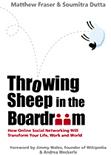
It would reasonable to predict that social networking sites like LinkedIn, Plaxo, Ning — and even Facebook — will see their membership ranks soar in coming weeks and months as widespread insecurity drives people to connect with others to boost their social capital.
There can be no doubt that, as people worry about their financial security and career situation, many will feel compelled to plug into online social networks. Anxious about their institutional status inside vertical hierarchies, people will turn to the social dynamics of horizontal networks.
The empirical data already appears to validate this hypothesis. In the spring when petrol prices were spiking, Neilson released findings that suggested people were networking online to “cope” with hard economic times. LinkedIn, meanwhile, has been boasting soaring membership numbers, reaching 28 million worldwide.
Nobody will be surprised to learn that many of LinkedIn’s new sign-ups are coming from the financial sector, whose membership has doubled. It may be hard to feel sorry for bonus-bloated investment bankers, but many are frantically dusting off their CVs and rushing to online social networks in the hope of repositioning their careers.
A new LinkedIn survey has revealed that 42 per cent of the network’s members feel their job security has been impacted by the economic crisis, while 13 per cent say it’s too soon to tell. In other words, more than half of LinkedIn’s worldwide membership is scared.
Some have dismissed LinkedIn as “Facebook for losers” – in other words, for opportunists who are looking only out for themselves in the job market. This attitude underlines two fundamental tensions that we analyse in some detail in Throwing Sheep in the Boardroom. The first is the tension between rational and non-rational motivations to belong to social groups. The second is between “close” and “weak” social ties.
Motivations for joining social networking sites are varied and complex. At the risk of oversimplifying, we can classify motivations into two broad categories: rational and non-rational. Professionals who join sites like LinkedIn are primarily motivated by rational calculations related to their career interests. Most teenagers who collect “friends” on MySpace, on the other hand, are not looking to improve their career prospects. Their social interaction is motivated primarily by a non-rational instinct to forge social bonds based on common values, beliefs, passions and so forth.
Granovetter found that we rely on “weak tie” connections much more often than we think. Most intelligent job-seekers don’t turn to close friends or family for jobs, unless they are expecting to benefit from the advantages of cronyism or nepotism. Most turn to their extended network. And most business networks are based on relatively “weak tie” associations.
Which brings us back to the economic downturn. When out-of-work investment bankers scramble to sign up to LinkedIn, they are making a rational calculation. They’re not looking for friends; they are seeking to leverage the strength of weak ties.
What happens, however, when people start invading Facebook where “friend” values are embedded in the site’s social etiquette? It’s easy to see how a tension between non-rational and rational motivations could create conflict on Facebook. And yet Facebook is cluttered with self-promoters, career artists, and marketing entrepreneurs. Can these people really be considered “friends”? And just how many Facebook “friends” can we reasonably have anyway?
Anthropologists tell us that it’s impossible to maintain stable social relationships with more than 150 people. This is widely known as "Dunbar's Number" named after British anthropologist Robin Dunbar, who argued that the necessary ritual of “social grooming” breaks down in groups whose membership exceeds roughly 150.
If we apply Dunbar’s figure to all social networking sites, any “friend” list that exceeds 150 is not credible — and pushes social networking into the zone of rational calculation. Maintaining a professional network of more than 150 connections on LinkedIn might be plausible, but it would appear to be humanly impossible to maintain social relations with more than 150 different people. And yet many Facebook profiles feature “friend” lists that not only surpass that figure, but double, triple, and quadruple it. Some Facebook “friend” lists count in the thousands. Which leads to the question: is the virtual world exempt from basic laws of socio-anthropology?
While we ponder that question, it’s a safe bet that the economic downturn will boost sign-ups for sites like LinkedIn and Facebook. And that this membership drive will further blur the line between rational instincts to connect socially with like-minded people and rational calculations to build social networks for self-interested reasons.
Matthew Fraser is a Senior Research Fellow and Soumitra Dutta is Roland Berger Chaired Professor of Business and Technology at INSEAD. Their book, 'Throwing Sheep in the Boardroom: How Online Social Networking Will Change Your Life, Work and World', is published by Wiley.
-
View Comments
-
Leave a Comment


No comments yet.